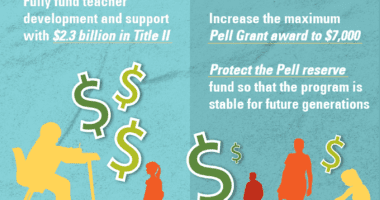NAEP Results Make it Clear: States Must Have Transparent College and Career Readiness Data
In October, the National Assessment of Education Progress (NAEP) 2019 12th grade reading and math scores were released and with them came an early warning signal for how schools prepare students for college and careers.
The NAEP is the only assessment with comparable results for all 50 states. And the latest scores indicate that due to huge inequities in our educational systems (e.g., access to strong and diverse teaching, standard-aligned assignments, lack of access to advanced coursework), student learning has not improved equally for all student groups:
- The percentage of Black and Latino students, English learners, and students from low-income backgrounds who performed below basic increased in both math and reading from 2015 — further widening gaps between these groups of students and their wealthier, White peers.
- Of Black 12th graders, 66% and 50% performed below basic in math and reading, respectively, compared to 29% and 21% of White students, respectively.
- And 12th grade students that performed higher on the NAEP assessment take more challenging/rigorous math and ELA courses than their peers.
Even more pressing, persistent inequities between groups are likely to widen given the COVID-19 pandemic. These results make it clear that policymakers, educators, and advocates must do more to ensure that all students, especially students with higher needs, are able to enroll in a degree-granting program and/or career pathway-oriented training program without the need for remediation. Early indications suggest many students will not be ready. How we respond to this early warning must be informed by robust data.
Yet, concerns abound as transparent and public reporting is lacking across states. At Ed Trust, we advocate that states must ensure key data on college and career readiness (CCR) is reported transparently and publicly. We explain three ways states can use data in their fight for equity:
- States should report on multiple CCR measures, as well as ensure that data on these measures is broken down for individual student groups so that families, advocates, and decisionmakers can ensure students have equitable access to various pathways. Under the Every Student Succeeds Act (ESSA), many states committed to collecting and reporting data on college and career readiness, including on measures related to AP/IB exams, dual enrollment credits, CTE pathway completion, work-based learning/technical skills certificates, ACT/SAT participation and performance, and military enlistment. Unfortunately, many states have fallen short on publicly reporting and disaggregating these metrics for individual student groups (e.g., race, income, English learner status). According to a recent report from Bellwether Education Partners, there are large discrepancies in the types of CCR measures states report on: only 23 states are in partial or full compliance with ESSA by disaggregating CCR measures by the required subgroups. This means that advocates and other concerned stakeholders are not able to compare readiness within or across states, to effectively identify inequities in CCR across student groups, or to target resources to areas of high need.
- States should adopt FAFSA completion as a high school graduation requirement and develop systems to track completion rates. Recent estimates suggest that FAFSA completions are on the decline nationally, largely as a result of the COVID-19 pandemic, and that declines are more pronounced in Title I schools (i.e., schools with a significant number of students from low-income backgrounds) and schools with a high concentration of Black and Latino students. The FAFSA opens the door to federal and state programs that many students need to fund their postsecondary path: research shows that 90% of high school seniors who complete the FAFSA go to college immediately after graduation compared with just 55% of seniors who do not complete the FAFSA. By adopting this requirement and developing FAFSA tracking systems, such as the one developed in Louisiana, states can ensure that college and career readiness is not thwarted by financial barriers that obstruct access, especially for the most marginalized student groups.
- To paint a full picture of college and career readiness and postsecondary student success, states should track, disaggregate, and report postsecondary enrollment rates, first-year persistence rates, and career and technical education (CTE) enrollment rates for all ESSA required subgroups. According to the Data Quality Campaign’s most recent analysis of state report cards, far too many states are not doing so:
- 15 states do not include postsecondary enrollment data in their report cards
- 25 states do not include CTE enrollment or completion data in their report cards
States need not reinvent the wheel but rather use existing tools to ensure data are reported transparently and publicly. For instance, states can use the National Student Clearinghouse to track immediate college cohort enrollment and first-year persistence rates and couple data with enrollment records to report on individual groups of students as ESSA requires. Tracking and reporting such measures completes the readiness picture and provides advocates and stakeholders with the data needed to pursue and fight for educational equity.
The NAEP 2019 12th grade results signal that we must fortify efforts to address persistent inequities between student groups in the area of college and career readiness. Data is one of the most important tools in this fight for educational equity, and states must rise to the occasion to ensure data reporting is done publicly and transparently. These inequities are likely to worsen as a result of the COVID-19 pandemic and resulting economic recession. Failing to acknowledge and appropriately respond to this early alert now will have far reaching effects, not only for students but for the nation.












